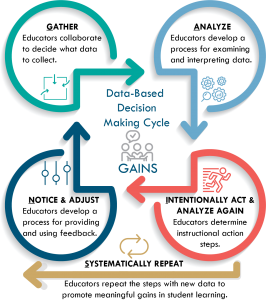OVERVIEW OF ESSENTIAL FUNCTION 3: INTENTIONALLY ACT AND ANALYZE AGAIN
| EF 3 and GAINS Step 3 | Actions |
|---|---|
| Educators determine instructional action steps = Intentionally Act & Analyze Again. | Create an instructional action plan that addresses the predicted breakdown.
Implement the plan, make instructional change, and generate MORE evidence data. |
How are you currently developing instructional plans and how do you know if the changes you are making impact student learning?
To be effective, there must be a direct link between the identified need(s) and the selected evidence-based instructional practices/strategies. Aligning instructional practices and instructional strategies during the decision-making process will increase the number of students likely to reach proficiency during an instructional cycle.
Linking Data to Instructional Practices
Once your team has identified critical areas to target, spend time brainstorming possible ways those learning needs could be impacted by future instruction.
Consider these reflection questions to link your inferences to instruction.
- Based on the problem we want to solve, what were students’ necessary prerequisite skills and knowledge?
- How is current instruction supporting students in acquiring or using prerequisite skills and knowledge to undertake the task?
- What questions can we ask to gather information about students’ knowledge and understanding of the task?
- What was the criteria used to define the success of the task?
- How might instruction be improved or modified to better advance learning?
- How can students be involved in defining success criteria or understanding that criteria better?
- What did our instruction around the task look like?
- Have students had enough time to practice new skills?
- What information about students’ knowledge and understanding did the practice produce?
- How was the feedback from practice used to advance students’ understanding?
- How were students involved in the feedback process?
Once you have considered multiple options and selected those your team believes will be most impactful, document your discussion and action plan. The Instructional Action Plan for DBDM (https://www.moedu-sail.org/wp-content/uploads/2019/02/DBDM-Workbook_Instructional_Action__Plan_Template-2019.pdf) and the Link to Teacher Practice Form (https://www.moedu-sail.org/wp-content/uploads/2019/02/DBDM-Workbook_Sample_Link_to_teacher_practice-2019.pdf) can be used to guide discussion and documentation.
Making Data Part of an Ongoing Cycle of Instructional Improvement
Watch the video “Making Data Part of an Ongoing Cycle of Instructional Improvement” and reflect on the following questions.
Making Data Part of an Ongoing Cycle of Instructional Improvement from WestEd iStudies on Vimeo.
Video Reflection Questions
- Do you and your team use multiple sources of data in an ongoing cycle to improve instruction for all students?
- How does collaboration improve this process?
- What are some ways you currently modify instruction to meet the needs of your students?
- When you make changes to instruction, how do you know if the change had an impact?


